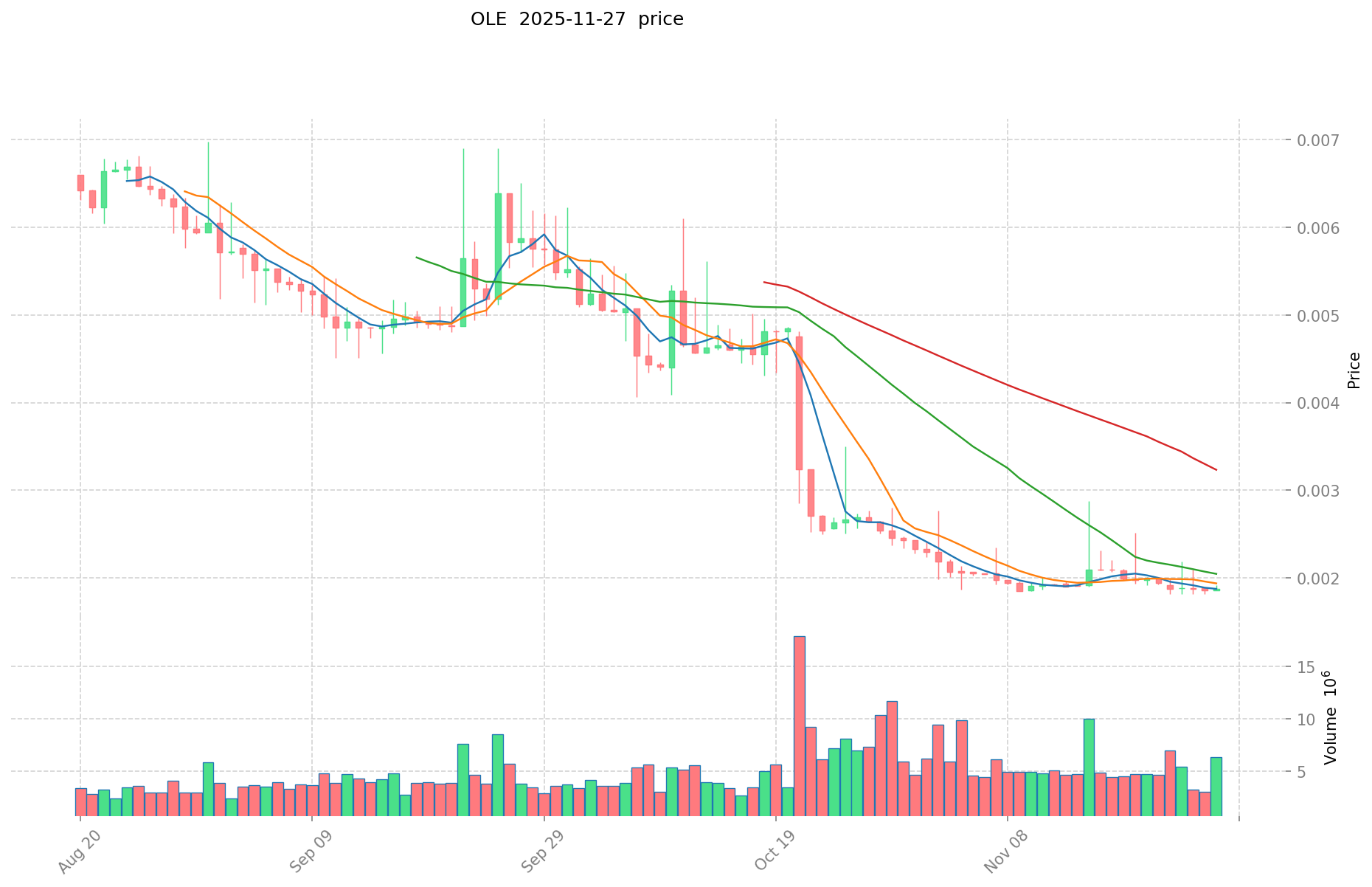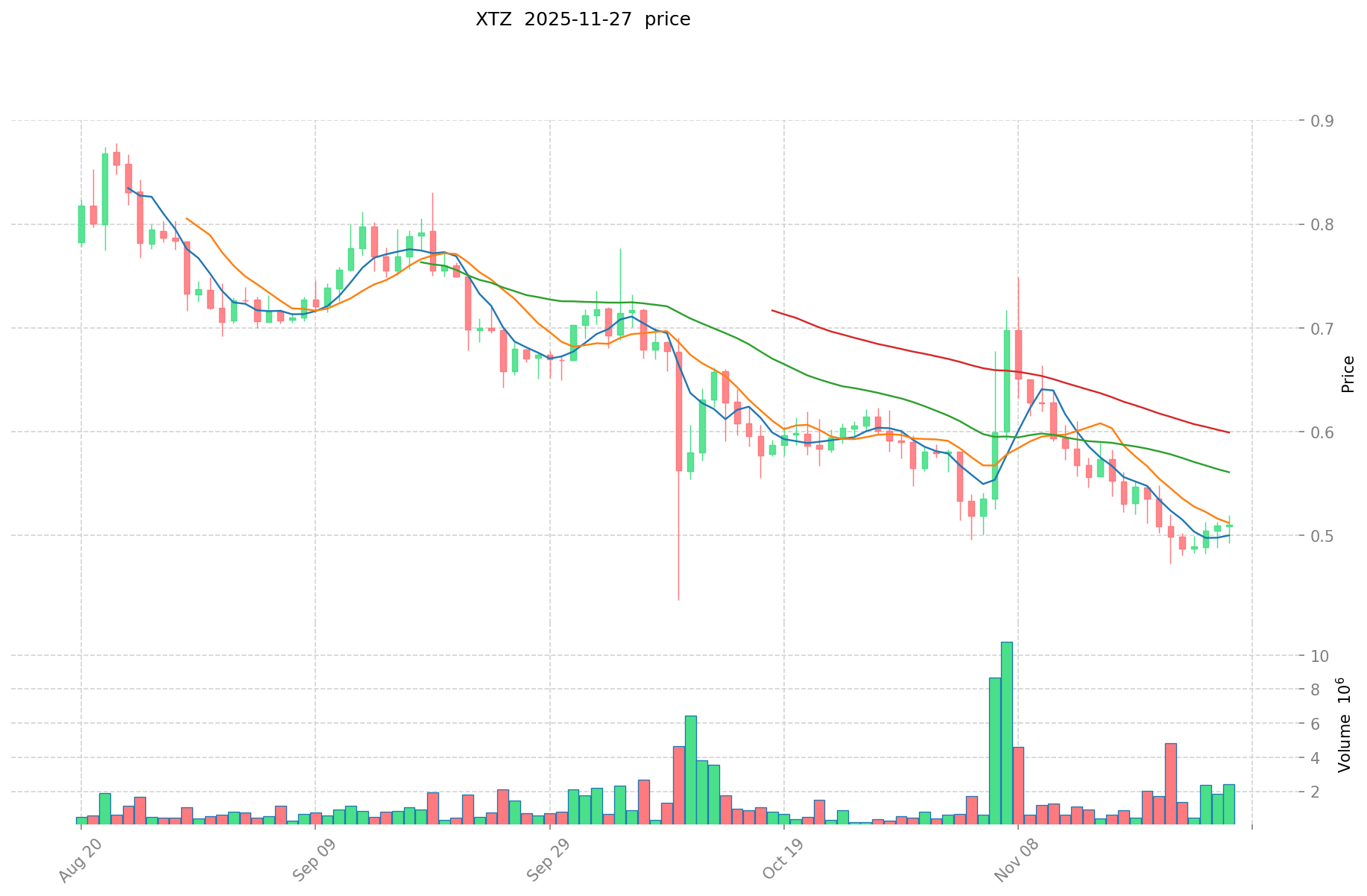OLE vs XTZ: Battle of the Blockchain Titans in the DeFi Arena
Introduction: OLE vs XTZ Investment Comparison
In the cryptocurrency market, the comparison between OpenLeverage (OLE) and Tezos (XTZ) has been an unavoidable topic for investors. The two not only show significant differences in market cap ranking, application scenarios, and price performance but also represent different positioning in the crypto asset space.
OpenLeverage (OLE): Since its launch, it has gained market recognition for its permissionless lending and margin trading protocol.
Tezos (XTZ): Introduced in 2017, it has been hailed as a self-amending blockchain, becoming one of the cryptocurrencies with significant global trading volume and market capitalization.
This article will provide a comprehensive analysis of the investment value comparison between OLE and XTZ, focusing on historical price trends, supply mechanisms, institutional adoption, technological ecosystems, and future predictions, attempting to answer the question that concerns investors the most:
"Which is the better buy right now?"
I. Price History Comparison and Current Market Status
OLE and XTZ Historical Price Trends
- 2022: XTZ reached its all-time high of $9.12 on October 4, 2021, but has since experienced a significant decline.
- 2025: OLE hit its all-time low of $0.00181399 on November 25, 2025, showing a steep drop from its previous peak.
- Comparative analysis: In the recent market cycle, OLE has fallen from its all-time high of $0.155627 to its current price of $0.001897, while XTZ has declined from its peak of $9.12 to $0.514.
Current Market Situation (2025-11-27)
- OLE current price: $0.001897
- XTZ current price: $0.514
- 24-hour trading volume: OLE $11,911.19 vs XTZ $936,440.02
- Market Sentiment Index (Fear & Greed Index): 22 (Extreme Fear)
Click to view real-time prices:
- View OLE current price Market Price
- View XTZ current price Market Price


II. Key Factors Influencing OLE vs XTZ Investment Value
Supply Mechanisms Comparison (Tokenomics)
- OLE: Fixed maximum supply of 10 billion tokens with a deflationary mechanism
- XTZ: Inflationary model with no maximum cap, annual inflation rate around 5.5%
- 📌 Historical Pattern: Deflationary assets like OLE tend to experience price appreciation in bull markets due to supply constraints, while XTZ's inflation model provides sustainability for network operation but may create selling pressure.
Institutional Adoption and Market Applications
- Institutional Holdings: XTZ has more established institutional adoption with Coinbase Custody support and involvement from the Tezos Foundation
- Enterprise Adoption: XTZ has gained traction in enterprise applications including STO issuance and partnerships with major firms like Manchester United and McLaren Racing
- Regulatory Attitudes: XTZ has better regulatory clarity in most jurisdictions, while OLE's regulatory status is still developing
Technical Development and Ecosystem Building
- OLE Technical Upgrades: Implementation of gasless transactions and multi-chain strategy
- XTZ Technical Development: Regular protocol upgrades through on-chain governance and focus on formal verification for security
- Ecosystem Comparison: XTZ has a more mature ecosystem with established DeFi protocols, NFT marketplaces, and enterprise applications, while OLE is still building its ecosystem with focus on cross-chain applications
Macroeconomic Factors and Market Cycles
- Inflation Environment Performance: XTZ offers staking rewards that can partially offset inflation, while OLE's fixed supply model may theoretically provide better protection against fiat inflation
- Macro Monetary Policy: Both tokens show correlation with broader crypto market reactions to interest rate changes and USD strength
- Geopolitical Factors: XTZ's formal verification focus appeals to institutions requiring regulatory compliance, while OLE's multi-chain approach aims to facilitate cross-border applications III. 2025-2030 Price Prediction: OLE vs XTZ
Short-term Prediction (2025)
- OLE: Conservative $0.001721 - $0.001891 | Optimistic $0.001891 - $0.002212
- XTZ: Conservative $0.354 - $0.513 | Optimistic $0.513 - $0.759
Mid-term Prediction (2027)
- OLE may enter a growth phase, with estimated price range $0.00148 - $0.00308
- XTZ may enter a growth phase, with estimated price range $0.629 - $0.827
- Key drivers: Institutional capital inflow, ETF, ecosystem development
Long-term Prediction (2030)
- OLE: Base scenario $0.003507 - $0.003653 | Optimistic scenario $0.003653 - $0.005077
- XTZ: Base scenario $0.741 - $0.962 | Optimistic scenario $0.962 - $1.212
Disclaimer: This analysis is based on historical data and market projections. Cryptocurrency markets are highly volatile and unpredictable. This information should not be considered as financial advice. Always conduct your own research before making investment decisions.
OLE:
| 年份 | 预测最高价 | 预测平均价格 | 预测最低价 | 涨跌幅 |
|---|---|---|---|---|
| 2025 | 0.00221247 | 0.001891 | 0.00172081 | 0 |
| 2026 | 0.00264673815 | 0.002051735 | 0.00170294005 | 8 |
| 2027 | 0.00307749991325 | 0.002349236575 | 0.00148001904225 | 23 |
| 2028 | 0.003201774528067 | 0.002713368244125 | 0.002007892500652 | 43 |
| 2029 | 0.004347629937561 | 0.002957571386096 | 0.002099875684128 | 55 |
| 2030 | 0.005077114919942 | 0.003652600661828 | 0.003506496635355 | 92 |
XTZ:
| 年份 | 预测最高价 | 预测平均价格 | 预测最低价 | 涨跌幅 |
|---|---|---|---|---|
| 2025 | 0.75924 | 0.513 | 0.35397 | 0 |
| 2026 | 0.6870096 | 0.63612 | 0.3371436 | 23 |
| 2027 | 0.826956 | 0.6615648 | 0.62848656 | 28 |
| 2028 | 0.826129044 | 0.7442604 | 0.439113636 | 44 |
| 2029 | 1.1385323469 | 0.785194722 | 0.63600772482 | 52 |
| 2030 | 1.211948053407 | 0.96186353445 | 0.7406349215265 | 87 |
IV. Investment Strategy Comparison: OLE vs XTZ
Long-term vs Short-term Investment Strategy
- OLE: Suitable for investors focused on DeFi and cross-chain potential
- XTZ: Suitable for investors seeking institutional adoption and ecosystem stability
Risk Management and Asset Allocation
- Conservative investors: OLE: 20% vs XTZ: 80%
- Aggressive investors: OLE: 60% vs XTZ: 40%
- Hedging tools: Stablecoin allocation, options, cross-currency combinations
V. Potential Risk Comparison
Market Risk
- OLE: Higher volatility due to smaller market cap and less liquidity
- XTZ: Vulnerability to broader market trends and institutional sentiment shifts
Technical Risk
- OLE: Scalability, network stability across multiple chains
- XTZ: Governance model efficiency, potential vulnerabilities in smart contracts
Regulatory Risk
- Global regulatory policies may have differing impacts on OLE and XTZ due to their distinct use cases and adoption levels
VI. Conclusion: Which Is the Better Buy?
📌 Investment Value Summary:
- OLE advantages: Deflationary model, cross-chain strategy, potential for high growth
- XTZ advantages: Established ecosystem, institutional adoption, self-amending blockchain
✅ Investment Advice:
- New investors: Consider a larger allocation to XTZ for its established market position
- Experienced investors: Balanced portfolio with both OLE and XTZ, adjusting based on risk tolerance
- Institutional investors: Focus on XTZ for its regulatory clarity and enterprise applications
⚠️ Risk Warning: The cryptocurrency market is highly volatile. This article does not constitute investment advice. None
VII. FAQ
Q1: What are the key differences between OLE and XTZ in terms of supply mechanisms? A: OLE has a fixed maximum supply of 10 billion tokens with a deflationary mechanism, while XTZ has an inflationary model with no maximum cap and an annual inflation rate of around 5.5%.
Q2: Which token has shown better institutional adoption? A: XTZ (Tezos) has demonstrated more established institutional adoption, with support from Coinbase Custody and involvement from the Tezos Foundation. It also has partnerships with major firms like Manchester United and McLaren Racing.
Q3: How do the ecosystems of OLE and XTZ compare? A: XTZ has a more mature ecosystem with established DeFi protocols, NFT marketplaces, and enterprise applications. OLE is still building its ecosystem, focusing on cross-chain applications and implementing gasless transactions.
Q4: What are the price predictions for OLE and XTZ by 2030? A: For OLE, the base scenario predicts a range of $0.003507 - $0.003653, with an optimistic scenario of $0.003653 - $0.005077. For XTZ, the base scenario predicts $0.741 - $0.962, with an optimistic scenario of $0.962 - $1.212.
Q5: How do the investment strategies differ for OLE and XTZ? A: OLE is more suitable for investors focused on DeFi and cross-chain potential, while XTZ is better for those seeking institutional adoption and ecosystem stability. Conservative investors might allocate 20% to OLE and 80% to XTZ, while aggressive investors might opt for 60% OLE and 40% XTZ.
Q6: What are the main risks associated with investing in OLE and XTZ? A: OLE faces higher volatility due to its smaller market cap and less liquidity, as well as potential scalability issues. XTZ is vulnerable to broader market trends and institutional sentiment shifts, with possible risks in its governance model efficiency and smart contract vulnerabilities.
Q7: Which token might be more suitable for different types of investors? A: New investors might consider a larger allocation to XTZ for its established market position. Experienced investors could balance their portfolio with both OLE and XTZ. Institutional investors may focus more on XTZ due to its regulatory clarity and enterprise applications.
Share
Content